MSI P35 Neo2-FR: Platinum performance for under $100
by Gary Key on December 5, 2007 11:00 PM EST- Posted in
- Motherboards
Memory Testing and Overclocking
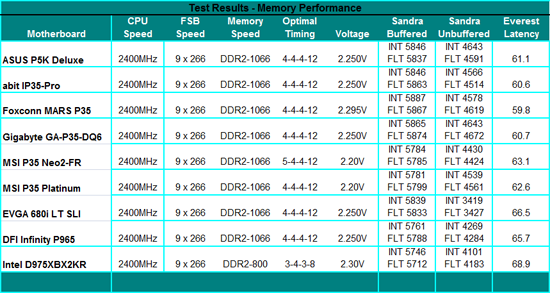 |
The MSI P35 Neo2-FR latency and unbuffered scores trail other P35 boards slightly. This is due in part to running CAS 5 instead of CAS 4 at DDR2-1066 and MSI setting tRD to 5 at this level for absolute stability. Our board would run 4-4-4-12 timings but required 2.4V to pass all benchmarks. That voltage level is unacceptable to us. However, we will see overall performance is still extremely competitive with the other P35 boards.
E2160 9x390
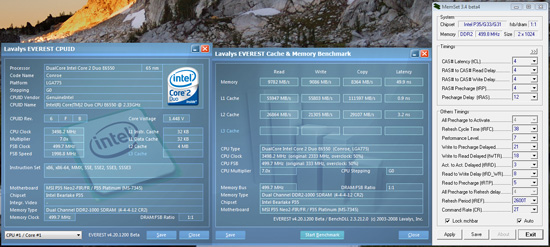 |
Our best performance results with this processor were at a final FSB setting of 390 with a 2GB memory configuration at the 4:5 ratio and 4-4-4-12 timings. This results in the board setting performance level (tRD) to 5 but required 2.2V for memory. MCH voltage is set to 1.40V and CPU voltage is at 1.4750V, with Vdrop/Vdroop realizing a final 1.44V during normal operation. The highest FSB we have been able to attain with this CPU is 410 on the DFI P35 board.
E6550 7x500
 |
We were able to reach a final FSB setting of 500 with our retail E6550. Our 2GB memory configuration used a 1:1 ratio with 4-4-4-12 timings. This results in the board setting performance level (tRD) to 7. MCH voltage is set to 1.45V, memory voltage to 2.20V, and CPU voltage is set to 1.4750V with Vdrop/Vdroop realizing a final 1.44V during normal operation. The highest FSB we have been able to attain with this CPU is 510 on the DFI P35 board. Our handpicked E6550 will reach 7x535 on this board while attaining 7x550 on the abit IP35-Pro and MSI Platinum boards.
Q6600
9x415
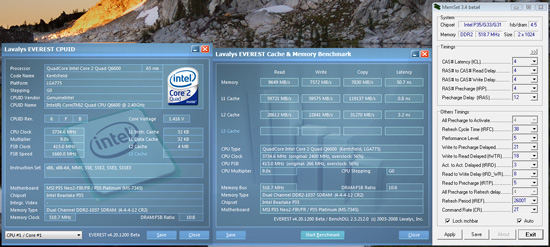 |
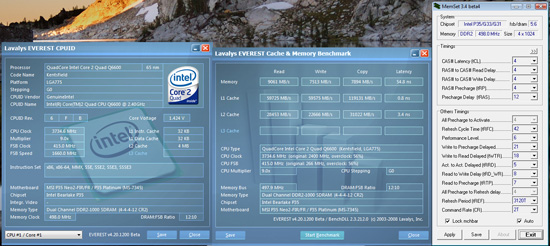 |
Our max CPU results on air-cooling resulted in a final 9x415 setting. Our 2GB memory configuration uses the 4:5 ratio with 4-4-4-12 timings and performance level (tRD) at 5. The 4GB memory configuration uses a 5:6 ratio, memory timings at 4-4-4-12, and tRD at 6. This results in lower performance of 1%-2% during application testing in a variety of benchmarks. We did complete our benchmark test suite with 4GB at the 4:5 ratio but this required MCH voltage at 1.6V and memory at 2.4V, neither of which is acceptable for air-cooling and 24/7 usage. The results for both memory configurations use MCH voltage at 1.450V, memory voltage at 2.20V, and CPU voltage at 1.4675V with Vdrop/Vdroop realizing a final 1.41V during normal operation. We also set VTT to 1.30V and SB I/O to 1.7V. It seemed anytime we clocked this board up, we had to set SB I/O to 1.7V or 1.8V with quad-core CPUs.
Q6600
8x465
 |
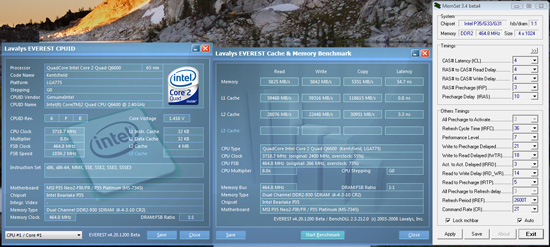 |
We reach a maximum FSB of 465 with quad-core on air-cooling using an 8X multiplier. Our 2GB memory configuration uses the 5:6 ratio with 4-4-4-12 timings; performance level (tRD) is set to 6 for a final speed of DDR2-1116. The 4GB memory configuration is at a 1:1 ratio, memory timings at 4-4-3-10, and tRD at 7. This again results in lower performance of around 1%-3% during application in a variety of benchmarks. We were able to run the 4:5 ratio with 2GB of memory installed for a final DDR2-1162 setting with 5-5-4-15 timings but at 2.4V. Our 4GB memory configuration was not stable at 4:5 or 5:6 regardless of voltages and reasonable timings, but we a bigger problem as well.
The problem is that once we started to raise the FSB over 445 with the Q6600 or QX6850 processors, the board automatically (drastically) reduced chipset timings and memory sub-timings. We have noticed this occurring on a couple of other budget level P35 boards and figure the manufacturer is trying to save the board - or maybe reach artificially high FSB rates with quad-core CPUs. We feel that the FSB rates are deceiving, as most boards have to compensate for higher FSB rates with increased strap settings and looser chipset/memory timings. When comparing application results during overclocking testing with the 8x465 and 9x415 results, we noticed a 3%-6% difference in memory sensitive benchmarks after compensating for the slightly higher CPU speeds in the 9x415 setting. Our advice on this board is to run lower FSB rates at higher multipliers with quad-core in order to maximize performance.
The final settings for each memory configuration is MCH voltage at 1.55V, memory voltage at 2.20V, and CPU voltage at 1.4675V with Vdrop/Vdroop realizing a final 1.41V during normal operation. We set VTT to 1.30V and SB I/O to 1.8V.
Q6600
9x400 2GB Module Testing
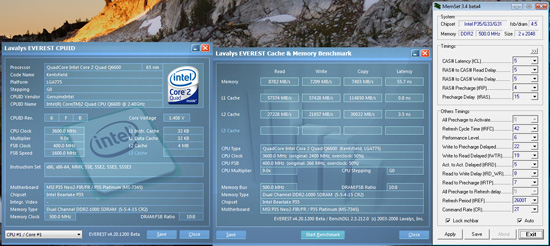 |
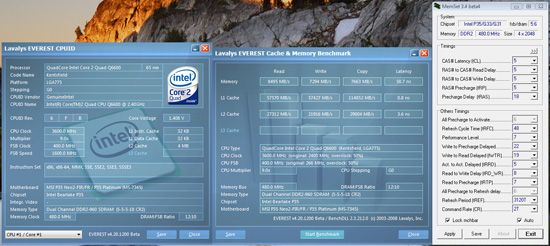 |
OCZ was kind enough to send us some of their new ReaperX 2GB modules for 4GB and 8GB testing. We have reached DDR2-1100 with 8GB on the DFI P35 board at 5-5-4-15 timings. However, in our initial testing of several boards, we have noticed that BIOS tuning for 2GB modules is not up to par with 1GB modules. We expect this to improve over time. We can say that our Neo2-FR BIOS could use additional tuning, but it still performs extremely well and stability was never a problem once we dialed in the memory settings.
We utilize a 9x400 setting with our Q6600 set to 1.4375V, MCH at 1.450V, and VTT at 1.30V. Memory voltage was set to 2.1V as recommended. Our 4GB memory configuration uses a 4:5 ratio at 5-5-4-15 timings with performance level (tRD) at 6, which results in a DDR2-1000 memory speed. The 8GB memory configuration uses a 5:6 ratio, memory timings at 5-5-5-18, and tRD at 7. This results in fractionally lower performance (~1%) during application testing with a variety of benchmarks.
The overclocking capability of this motherboard is very good, if not excellent for the price. The board's stability will start to trail off when you are near its limits so there is feedback from the board before you go over the edge. The board does not overclock quite as well as the DFI P35 TR or Gigabyte GA-P35-DQ6 boards, but at 39% of the cost, we think it more than fits the bill as a performance oriented budget board. However, we hope MSI can fine tune 2GB module performance further and work on 4:5 memory ratio compatibility with 4x1GB configurations. If we could change one item with the overclocking capabilities, it would be allowing 4:5 ratio capabilities above DDR2-1000 with 4x1GB installations. Of note, the BIOS recovery system worked extremely well when we exceeded the limits of the board. However, it was sometimes necessary to perform a full shutdown and startup procedure when resetting the board.










35 Comments
View All Comments
drebo - Friday, December 7, 2007 - link
I'll forgive your ignorant comment since you obviously do not work in retail computer sales. People aren't interested in buying adapters and add-on cards that they don't feel they should need because "their old computer had it." In a managed IT environment, yes, you can just give everyone converters and it works fine, but your average joe who walks into a computer shop with a 10-year-old dead computer and an ancient Epson parallel printer isn't ever going to understand why his old connections are going by the way-side.So, yes, legacy support in the retail market is important, even for most small business users. Not a day doesn't go by when I get a call or someone comes in needing a parallel card or serial card because the off-the-shelf computer they bought doesn't come with one. Most people don't need 16 USB ports, but I'll bet a good number do need a parallel port.
AssBall - Saturday, December 8, 2007 - link
"I'll forgive your ignorant comment since you obviously do not work in retail computer sales."Right... because a good retail computer salesperson would sell someone who is inexperienced enough to not RTFM a 10$ adapter instead of reccomending a better and higher profit margin 10 year newer replacement product for 150$ with built in factory support$
Salesman indeed...
kmmatney - Thursday, December 6, 2007 - link
Serial mice? Come-on! I used serial mice back in the day, but there is absolutely no need to get a USB mouse - I just bought a spare optical mouse for $3 at Microcenter - works great. You can get a USB-RS232 adapter for around $15 as well. Or you can buy a PCI add-on card, with RS232 and Parallel ports, for around the same price. I'd way rather have the extra USB and e-Sata ports instead of the legacy crap.I do a lot of RS-232 and RS-485 programming, and my main computer is a laptop, so I've been using USB-Serial converters for some time now.
theslug - Thursday, December 6, 2007 - link
They sell these:http://www.newegg.com/Product/ProductList.aspx?Sub...">http://www.newegg.com/Product/ProductLi...iption=u...
OndrejSc - Thursday, December 6, 2007 - link
Cheer up! It does exist. :-)http://global.msi.com.tw/index.php?func=proddesc&a...">http://global.msi.com.tw/index.php?func...=1342&am...
drebo - Thursday, December 6, 2007 - link
Hmmm, good news. I wonder when we'll have availability and what the pricing will be like.LoneWolf15 - Thursday, December 6, 2007 - link
"MSI also offers the Creative Lab's X-Fi audio codecs on their high-end boards as a nod to the gaming community."No...MSI puts the X-Fi XtremeAudio chip on the boards, which is a tweaked Audigy SE chip (note: the Audigy SE isn't even a true Audigy chip), not a true X-Fi. No hardware EAX or DirectSound3D acceleration, and the drivers, like the X-Fi XtremeAudio card, are completely different than the rest of the X-Fi line. So, serious gamers STILL need to buy a sound card.
I really like MSI and use their boards a lot, but this audio solution is really only slightly better than what is used on other boards --and those who don't like Creative might argue that the drivers actually make it worse. If MSI had used the real X-Fi chip, I'd be very impressed.
ultimatex - Thursday, December 6, 2007 - link
are u retarted ? serious gamers need to buy a seperate sound card? A real serious games would not be worrying about some sound options but more about performace of the board. I smell some Asus Gybabyte fan boys here on these forums.as long as boards have 5.1 sound U dont need no special features that dont do anything specialy for games. Serious games wear headphones.
these NERDS here are sounding like if a serious gamer has to have a sound card . Well ill tell u from a X-Cal P Css Player here. A videocard and Fps is the most important thing for a Hardcore gamer..
Etern205 - Friday, December 7, 2007 - link
Your the retarded one.If he's right and that the onboard X-FI does not have hardware accelerated audio, what it means it it uses the cpu to process the audio singal which leads to reduce FPS. Gamers needs to know where their enemies are and that's where the EAX comes in. Onboard will have EAX as well as mutli-channel speaker support (ie 5.1 surround sound) but without a higher version of EAX (ie EAX 5.0) all your hearing are just sounds coming at you with no sense of direction.
So if you got a 5.1 speaker setup but with a crappy onboard Audio or onboard X-FI with crappy EAX support then it won't help you as much as a dedicated sound card.
dazy - Tuesday, December 11, 2007 - link
Thanks for pointing out his utter ignorance before I had to, lol.[quote=ultimatex]serious gamers need to buy a seperate sound card?
as long as boards have 5.1 sound U dont need no special features that dont do anything specialy for games. Serious games wear headphones.
A videocard and Fps is the most important thing for a Hardcore gamer..[/quote]
The sheer number of stupid statements for a "gamer" in his post is outstanding. Maybe he thinks we are talking about his XBOX360? ;-)